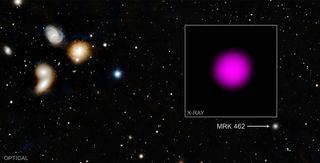A recently discovered supermassive “mini” black hole could help reveal some of the secrets of the cosmos’ biggest black holes.
Researchers using NASA Chandra X-ray Observatory recently discovered a monstrous black hole which has been “buried” in the dust and gas of a dwarf galaxy, according to a statement from the Chandra team. The black hole, which is about 200,000 times the mass of our sun, sits at the center of the dwarf galaxy Mrk 462, and, although it is huge, it is one of the smallest supermassive black holes ever to be discovered. .
“This black hole in Mrk 462 is among the smallest of the supermassive black holes, or monsters,” said Jack Parker, a researcher at Dartmouth College in New Hampshire who co-led the study identifying and studying this black hole, said stated in the press release. . “Black holes like this are notoriously hard to find.”
Related: Eureka! Scientists photograph black hole for the first time
The host galaxy of Mrk 462 has “only” several hundred million stars. Although this may sound like a lot, our Milky Way galaxy has a few hundred billion stars, so this number classifies Mrk 462 as a dwarf galaxy, according to the release.
So far, the black hole has been obscured from our view, clouded by dust and gas in Mrk 462. In a larger galaxy, scientists might be able to find a black hole by observing rapidly moving stars. in the center of a galaxy (signs of gravitational attraction the influence of a black hole), but that would not be possible in such a small galaxy. Instead, the team was able to use Chandra to see the brilliant x-rays emitted by gas sucked into the black hole.
This is, in fact, one of the first times that a black hole obscured by gas and dust in this way has been observed in a dwarf galaxy, the statement said.
“Because buried black holes are even more difficult to detect than exposed holes, finding this example could mean that there are many more dwarf galaxies with similar black holes,” said the study co-director. Ryan Hickox, also a researcher at Dartmouth, in the same statement. “This is important because it could help answer a major question in astrophysics: how did black holes get so big so early in the universe?”
The team is hoping the discovery could help advance the conversation about how supermassive black holes grew to such incredible sizes so quickly in the early universe, a lingering scientific mystery.
There are a number of competing theories that seek to explain how supermassive black holes in our universe “might gain weight quickly enough to reach the sizes seen in the early universe,” as Chandra’s statement puts it.
Every galaxy is believed to have stellar mass black holes, but few supermassive black holes have been confirmed to exist in dwarf galaxies. So, discoveries like this could help explain their existence.
“We cannot draw any solid conclusions from an example, but this result should encourage much more research into black holes buried in dwarf galaxies,” Parker said of the discovery. “We are delighted with what we could learn. “
This work was presented Jan. 10 at the 239th meeting of the American Astronomical Society in Salt Lake City and as part of a virtual press conference.
Email Chelsea Gohd at [email protected] or follow her on Twitter @chelsea_gohd. Follow us on twitter @Spacedotcom and on Facebook.
 Universo Viviente
Universo Viviente




